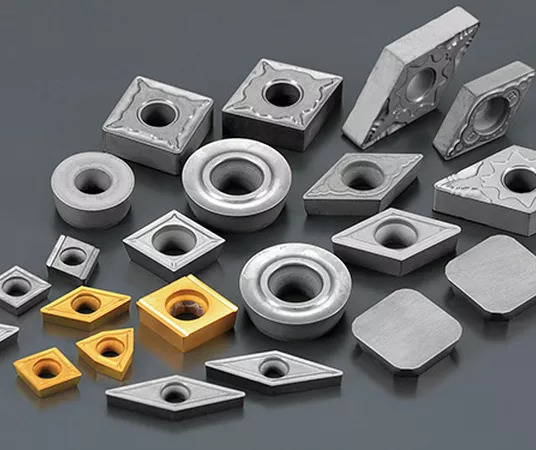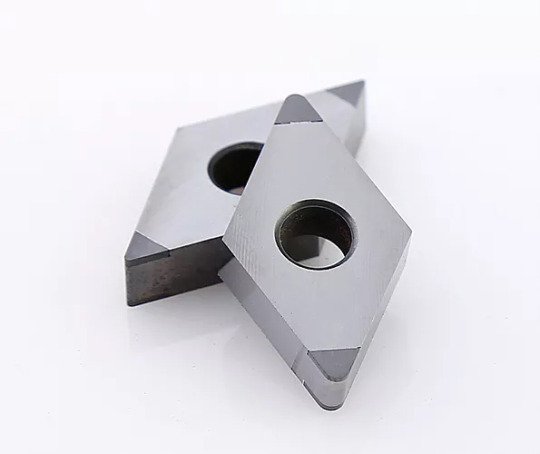Text
Cubic Boron Nitride (CBN) inserts are cutting tools made from a synthetic material that is second only to diamond in hardness. They are widely used in machining applications due to their exceptional properties. Here are the key benefits of using CBN inserts in machining processes:
**1. High Hardness and Wear Resistance:
Exceptional Hardness: CBN is one of the hardest known materials, providing excellent wear resistance during cutting operations.
Long Tool Life: CBN inserts have a longer tool life compared to traditional carbide inserts, reducing the frequency of tool changes and increasing productivity.
**2. High Thermal Stability:
Heat Resistance: CBN inserts can withstand high cutting temperatures without losing their hardness or shape. This makes them suitable for high-speed machining and applications involving heat-resistant materials like hardened steels and superalloys.
Reduced Thermal Stress: CBN inserts generate less heat during cutting, leading to reduced thermal stress on both the tool and the workpiece.
**3. High Chemical Stability:
Chemical Inertness: CBN is chemically inert, making it resistant to chemical wear. This property allows CBN inserts to perform well in applications involving abrasive and corrosive materials.
**4. Superior Surface Finish:
Excellent Surface Finish: CBN inserts produce superior surface finishes on machined parts due to their sharp cutting edges and wear-resistant properties. This is especially important in applications where surface quality is critical, such as in the aerospace and automotive industries.
**5. Versatility and Adaptability:
Wide Range of Applications: CBN inserts are versatile and can be used for various machining operations, including turning, milling, boring, and threading.
Suitable for Hard Materials: CBN inserts are highly effective for machining hard materials such as hardened steels, cast iron, and heat-resistant alloys.
**6. Increased Productivity:
Higher Cutting Speeds: CBN inserts allow for significantly higher cutting speeds compared to conventional carbide inserts. This leads to increased machining efficiency and productivity.
Reduced Downtime: Due to their extended tool life, CBN inserts reduce downtime associated with tool changes and replacements.
**7. Cost Savings:
Longer Tool Life: CBN inserts have a longer operational lifespan, reducing the frequency of tool replacements and overall tooling costs.
Improved Efficiency: Higher cutting speeds and superior surface finishes contribute to improved efficiency, leading to potential cost savings in manufacturing processes.
**8. Environmental Benefits:
Reduced Material Waste: Longer tool life results in reduced material waste from used inserts, contributing to environmental sustainability.
In summary, CBN inserts offer significant advantages in terms of durability, performance, and cost-effectiveness in machining operations. Their ability to withstand high temperatures, maintain sharp cutting edges, and produce excellent surface finishes makes them invaluable tools for manufacturers across various industries.

#cbn#CBN Inserts#CBN#Cutting Tools#Machine Tools#Ceramic Inserts#cutting#ceramic#carbide#metalwork#tool#drill bits#grinder#2023#metal#distributor#cnctools#removals#deburring#grinding#shaping#automotive#aerospace#engineering
0 notes
Text
Ceramic Inserts
Ceramic inserts are cutting tools made from advanced ceramic materials such as alumina (Al2O3), silicon nitride (Si3N4), or silicon carbide (SiC). They are widely used in various industrial applications, particularly in machining processes, due to their exceptional hardness, wear resistance, and high-temperature stability. Here are some key aspects of ceramic inserts for industrial use:
1. Types of Ceramic Inserts:
a. Alumina Inserts:
Alumina (Al2O3) Inserts: Alumina ceramic inserts are known for their high hardness and excellent wear resistance. They are suitable for machining ferrous and non-ferrous materials.
b. Silicon Nitride Inserts:
Silicon Nitride (Si3N4) Inserts: Silicon nitride ceramic inserts offer high-temperature stability, thermal shock resistance, and exceptional wear resistance. They are often used in high-speed machining of heat-resistant alloys and hardened steels.
c. Silicon Carbide Inserts:
Silicon Carbide (SiC) Inserts: Silicon carbide ceramic inserts are extremely hard and wear-resistant. They are used in high-speed machining of non-ferrous materials, such as aluminum and copper alloys.
2. Advantages of Ceramic Inserts:
High Hardness: Ceramic inserts are much harder than conventional carbide inserts, resulting in longer tool life and improved wear resistance.
High-Temperature Stability: Ceramics can withstand high cutting temperatures without losing their hardness or shape, making them suitable for high-speed machining and applications involving heat-resistant materials.
Chemical Inertness: Ceramic materials are resistant to chemical wear, making them suitable for machining abrasive and corrosive materials.
Excellent Surface Finish: Ceramic inserts can produce superior surface finishes on machined parts due to their sharp cutting edges and wear-resistant properties.
3. Applications:
Turning: Ceramic inserts are used for turning applications involving hard and heat-resistant materials.
Milling: They are employed in milling operations, especially when high-precision and superior surface finish are required.
Drilling: Ceramic inserts are used in drilling applications for efficient hole-making in challenging materials.
High-Speed Machining: Due to their high-temperature stability, ceramic inserts are ideal for high-speed machining processes.
4. Considerations:
Cutting Speeds: Ceramic inserts allow for higher cutting speeds compared to traditional carbide inserts, enhancing productivity.
Workpiece Material: Ceramic inserts are best suited for machining hard and heat-resistant materials, such as aerospace alloys, hardened steels, and superalloys.
Coolant and Lubrication: Proper coolant and lubrication systems are essential to dissipate heat during machining processes, ensuring longer tool life and optimal performance.
Ceramic inserts offer significant advantages in terms of durability and performance, making them valuable tools in various industrial applications where high precision and efficiency are essential. Proper selection, machining parameters, and tool maintenance are crucial to maximizing the benefits of ceramic inserts in industrial processes.

#ceramics#inserts#carbide#tooling#machinery#CNC#cutting#ceramic#metalwork#tool#drill bits#grinder#2023#metal#distributor#cnctools#removals#deburring#grinding#shaping#automotive#aerospace#foundary#engineering#suppliers
0 notes
Text

Carbide inserts are cutting tools used in machining processes to remove material from workpieces. They are made from carbide, which is a composite material made up of tungsten carbide particles held together by a metallic binder, typically cobalt. Carbide inserts are commonly used in turning, milling, drilling, and boring operations.
Carbide inserts are known for their high hardness, wear resistance, and ability to withstand high temperatures. They can maintain a sharp cutting edge for longer periods of time than other cutting tools made from conventional materials like high-speed steel. This makes carbide inserts ideal for high-volume machining operations where long tool life is essential.
Carbide inserts come in a variety of shapes and sizes to suit different machining applications. They are typically mounted onto specialized tool holders, which provide the necessary support and stability during machining operations. Some carbide inserts are designed to be indexable, which means that they can be rotated or flipped to use different cutting edges and extend the life of the insert.
Carbide inserts are also available with different coatings that provide additional benefits such as improved wear resistance, reduced friction, and increased tool life. Examples of such coatings include titanium nitride (TiN), titanium carbonitride (TiCN), and aluminum oxide (Al2O3).
#cutting#ceramic#carbide#metalwork#tool#drill bits#grinder#2023#metal#distributor#cnctools#removals#deburring#grinding#shaping#automotive#aerospace#foundary#engineering#suppliers
0 notes
Text
CBN Inserts Suppliers

CBN (Cubic Boron Nitride) inserts are cutting tools used in the machining industry. They are made of a very hard and durable material that is second only to diamond in hardness. CBN inserts are commonly used for machining hard materials such as hardened steel, cast iron, and superalloys.
CBN inserts are designed to provide superior cutting performance, with high speed, high efficiency, and long tool life. They are often used in high-precision machining applications, where high accuracy and surface finish are critical.
CBN inserts come in a variety of shapes and sizes, including square, round, triangular, and diamond-shaped. They can be mounted on various types of cutting tools, including turning and milling tools, boring bars, and grooving tools.
CBN inserts are typically more expensive than other cutting tools, but they can provide significant cost savings in the long run by reducing tool changeover times and increasing machining productivity.
Inserts Suppliers
#CBN#Inserts#Machenzzo#Carbide Inserts#cutting#ceramic#carbide#metalwork#tool#drill bits#grinder#2023#metal#distributor#cnctools#removals#deburring#grinding#shaping#automotive#aerospace#foundary#engineering#suppliers
0 notes
Text
Ceramic Inserts Suppliers
Our premium ceramic grades ensure higher productivity. All of the grades show superior high temperature hardness, heat resistance and chemical stability. We offer many types of ceramic cutting tool materials (silicon nitride-based, alumina-based and whisker-based) in a variety of geometries to meet customer demands.

#Machenzzo#ceramics#cbn#carbide#Cuttingtools#cutting#ceramic#metalwork#tool#drill bits#grinder#2023#metal#distributor#cnctools#removals#deburring#grinding#shaping#automotive#aerospace#foundary#engineering#suppliers
1 note
·
View note